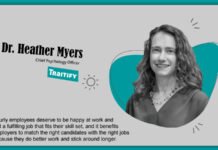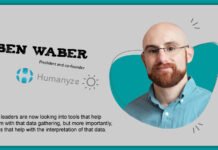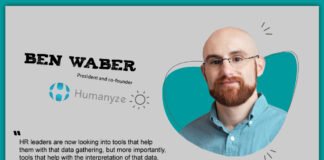Dylan and Mark from 3Sixty Insights discuss SMB hiring, HR tech trends, AI tools, and isolved’s evolving talent solutions.
Dylan and Mark, it’s a pleasure to have you with us at HRTech Cube. To begin, we’d love to hear a little about your professional journeys leading up to your current roles at 3Sixty Insights.
Dylan: I have always enjoyed writing, and I stepped into my first professional writing role as a Proposal/RFP writer at Ceridian (now Dayforce). From there, I was contracted as a sales and marketing writer at UKG while simultaneously working as a writer for 3Sixty Insights behind the scenes. As time went on and I honed my HR and workforce management knowledge with the help of Nick Biron, I began my analyst practice at 3Sixty Insights. It’s been an exciting journey for me, finding my voice in the industry and bringing my earlier career experience in a variety of service-related roles, as well as my academic background in geopolitics, into the mix.
Mark: I’ve been a journalist for 40 years, and journalism’s the foundation of my approach to HR tech. After spending 10 years in the news department of Dow Jones, I began doing a lot of corporate writing, which led me to focus on HR. In 2006, I became the North American editor of eFinancialCareers, then the first managing editor of Dice after it acquired eFC. I left Dice in 2014 to return to freelance writing, focused on HR and tech. In 2017, I started the HCM Technology Report, which I evolved into WorkforceAI.News. As a consulting analyst at 3Sixty Insights, I focus on HR’s use of advanced technology and how it impacts the workforce.
With ApplicantPro’s integration with isolved’s People Cloud, how do you both see this affecting the shifting dynamics within the recruitment process?
Mark: The acquisition puts ApplicantPro directly under isolved’s umbrella, which makes a ton of sense from both the business and user’s perspective. Adding ApplicantPro incorporates another set of capabilities into isolved’s platform, which have already been stress-tested because of the companies’ history together. For the businesses, this simplifies sales and marketing, and ensures alignment in technical and product development. For users/customers, it unifies support and customer service, and can potentially simplify the recruiting process by integrating more capabilities into isolved’s platform
Dylan: isolved’s integration of ApplicantPro into People Cloud addresses the shifting targets in modern recruiting. Especially for industries with high turnover, it streamlines applicant tracking, automates tasks, and improves candidate engagement. The goal is to reduce time-to-hire while enhancing applicant quality, given that post-hire retention is often painfully low for many industries. Streamlining the recruitment process and saving time is a primary focus. The aim is to give managers and people leaders time back in their days.
Mark, with your extensive experience in the HR tech space and your finger on the pulse of what’s happening in the business landscape, what do you believe is the primary obstacle SMBs face when adopting new recruiting tools like those from isolved and ApplicantPro?
The first obstacle is money: SMBs hate to spend it unless doing so is absolutely necessary, and they’re extremely price-sensitive on top of that. We like to talk about “ROI,” but to the business owner that means a couple of things: First, they want to see near-term, indeed almost immediate return on their spend. Second, any money they spend on HR technology is money they’re not able to spend somewhere else. Time is another issue. Decision-makers at SMBs usually wear several hats, so they’re always looking to streamline their work and avoid efforts that will give them more to do. Then there’s implementation. That requires both time and resources, either external or internal. When recruiters or managers spend time on training, they’re not accomplishing other tasks and goals. In SMBs, that can affect real money.
Dylan, in your view, how do isolved’s integrated solutions specifically enhance both the speed and the quality of hiring decisions for SMBs that are pressured to hire rapidly?
Isolved’s integrated solutions, especially with the addition of ApplicantPro, have consistently proven their ability to aid in the speed and quality of hiring for SMBs. They’ve been honing in and solidifying their gains in this sector for many years, and have become experts in bringing together job postings, applicant tracking, and onboarding for SMBs. This means fewer manual tasks and time saved, as well as a smooth end-to-end process that lets businesses thrive even when under pressure to hire quickly due to labor market pressures or make informed business decisions on the fly. It’s one less thing for SMBs to stress about.
Mark and Dylan, generative AI is increasingly prevalent. How do you both envision features such as AI-written job ads and video interviews transforming hiring for SMBs? Mark, I’d be particularly interested in your editorial perspective on this.
Mark: TA is an area where AI clearly helps improve time flows and workflows. Any company, large or small, wants to hire people who can do a job, and do it in a way that, at the minimum, doesn’t harm current projects and operations. Generative AI tools like writing job ads and video interviews simplify the recruiting process in a way that saves HR and hiring managers a notable amount of time. For one thing, this allows managers to spend more time on their core responsibilities. For another, it can empower managers by strengthening their work. Not everyone writes an effective job ad, for example. AI can help solve that. Its data can also help busy managers identify issues or traits with a particular candidate, improving the quality of hire. And, it can track and predict the performance of different channels, so searches can be conducted more efficiently. In addition, AI’s ability to spot trends and make recommendations can be a huge help to users evaluating candidates and TA issues. Remember, most SMB leaders are experts in their business and industry, not in recruiting or workforce management.
Dylan: Generative AI is a game changer for SMBs that may not have the time or resources to build out even a modest recruiting team. AI-written job ads help create more compelling and targeted postings in a fraction of the time, which can significantly boost visibility and attract the right candidates. For SMBs facing pressure to hire fast and stay competitive, these tools can level the playing field by making the hiring process both more efficient and more data-informed. Hopefully, this leads to more small, locally owned businesses, allowing us to break down the monopolization and market concentration of many industries that are hurting the American economy and innovation.
To Dylan, isolved highlights the use of proactive prompts and streamlined workflows. How do these elements contribute to improved communication and the reduction of delays in candidate engagement during the hiring process?
For SMBs that juggle multiple responsibilities, this can take a lot off their plates. Isolved’s proactive prompts notify hiring managers at the right moments, such as when a candidate applies, needs a follow-up, or is waiting for feedback from them. In industries where candidates have many other employment options, this can remove bottlenecks and keep them engaged to avoid slipping through the cracks. This means fewer unnecessary steps, fewer manual handoffs, and a more consistent and communicative response to candidates.
What does isolved’s ability to serve both SMBs and large enterprises suggest about broader trends in HR technology, Mark, and how does platform flexibility shape the narrative around future-ready talent solutions?
The ability to serve both large and small businesses is something more vendors should be thinking about. Most vendors focus on one market or the other. isolved has recognized where it can take advantage of common needs between the two. That gives it a wider market than its competitors may have. As challenging, though, is the need for messaging, communications, and support that addresses the needs of each market. Large companies have different priorities than SMBs, and simply relabeling a platform rarely addresses them.
Given your expertise in Human Capital Management, Dylan, what are the key talent acquisition challenges SMBs face, and how does isolved’s new offering address these challenges effectively?
Key Talent Acquisition Challenges for SMBs:
- High turnover and pressure to keep hiring quickly, especially in industries where turnover is constant
- Limited HR bandwidth or lack of HR entirely, meaning hiring falls in the lap of managers or owners who already have their plate full and may not have any recruiting expertise whatsoever.
- Outdated candidate experience or application processes that may still include paper applications or archaic technology that doesn’t prioritize the mobile-enabled hiring that younger generations expect.
- A lack of consistent protocols and processes around hiring leads to poor candidate communication and visibility and a higher probability of them falling through the cracks.
- Budget constraints: SMBs need affordable, scalable solutions that don’t sacrifice functionality.
How isolved Solves These Challenges:
- Built for SMBs: Designed to be cost-effective, easy to use, and scalable as business needs grow.
- Faster hiring: Automated job postings, screening, and workflows save time and reduce delays.
- Smart Prompts & Streamlined Processes: Proactive alerts and simplified task flows.
- Mobile-Friendly & User-Centric: Meets candidates where they are— on their phones—boosting application rates.
- End-to-End Integration: Hiring data seamlessly integrates with payroll, onboarding, and scheduling, eliminating manual work.
- Affordable & Scalable for QSRs: Purpose-built to support franchisees and operators with lean teams and significant needs.
Mark, what do you foresee as the next significant transformation in talent acquisition, and how are companies such as isolved and ApplicantPro positioning themselves to address this evolution?
I believe assessments will become even more important to talent acquisition than they already are. Already, there seems to be a disconnect between what the workforce offers and what employers need. For example, consider the discussion about skills gaps. With skills becoming more important, employers will need more and better tools to help them evaluate the complete candidate and their fit with current employees and corporate culture. A number of vendors already offer assessments, but I expect these to become a more prominent part of the process. In addition to offering robust features in their TA toolkit, vendors will have to create messaging and support services that provide employers with the information and assistance needed to leverage assessments in the most effective way for them.
For SMBs considering an increased adoption of HR technology, what are your individual top recommendations for harmonizing the benefits of automation with the imperative of delivering a personalized and human experience for both candidates and employees?
Mark: My first thought is for SMBs to be clear on what they need from an HR platform. It’s not only about the available tools, but also usability, integration, data, and compliance. Many SMBs think about hiring as “filling a spot as quickly as possible,” but obviously it’s about much more than that. Business owners need to understand how their employees – particularly those tasked with HR – work on both a project and day-to-day basis, then look at how a solution will fit into that work. That’s really the key because SMBs think mostly in terms of money and time. So, they’ll look at automation with an eye toward how it saves time without sacrificing quality. They’ll want to provide candidates and staff alike with a good experience, and so must be able to imagine the process users will go through in order to submit an application or make a hire. Business leaders can’t all be expected to be technology and data experts, but they are experts at running a company in a particular industry. That expertise applies directly to the needs of candidates and hiring managers, so business owners shouldn’t minimize it.
Dylan: Top Recommendations for SMBs Adopting HR Tech:
- Start with tools that solve daily pain points or problems and make a practical impact on your business. Too many businesses chase the newest or trendy tech. Technology is just another tool in the toolbox. Focus on automating repetitive, time-consuming tasks like scheduling, payroll, or application tracking.
This frees up time for your team to focus on higher-value, people-driven interactions. - Use automation to enhance – not replace – communication. Automate things like follow-ups and updates to keep candidates informed as quickly as possible, but ensure there’s a clear line of communication to real people when deeper engagement is required.
- Keep a human touch whenever possible. Over-automation of too many processes can make a business feel cold, hollow, and distant. AI-written job ads and application workflows are great, but messaging should convey company culture and communication standards early on.
- Use self-service wherever possible. Most employees these days are tech-savvy, even older generations. Look for systems that easily empower employees and candidates with a low learning curve and easy access, especially via smartphone or texting.
- Train managers to use tech to help them. Provide training to managers that includes ways to stay connected with employees while reducing overall workload to keep them away from the computer and engaging with employees or customers

Mark Feffer, 3Sixty Insights, ISOLVED & APPLICANTPRO
Mark Feffer is the editor of WorkforceAI.News and the HCM Technology Report, and Contributing Analyst of 3Sixty Insights. Recognized as one of the most trusted journalists covering HR technology, he has written for Reworked, TechTarget, HR Magazine, SHRM, TLNT and TalentCulture. His podcast PeopleTech is downloaded by tens of thousands of listeners each month. Previously, he was executive editor of RecruitingDaily and Managing Editor of Dice. Mark began his career as one of the first online editors for Dow Jones and The Wall Street Journal. He then worked with a variety of companies as a writer of feature articles, executive presentations and multimedia features. His clients included AT&T, Charles Schwab, Merrill Lynch, Bloomberg and Dow Jones. He has a Master of Science in Journalism from Northwestern University and a Bachelor of Science in Broadcasting and Film from Boston University. His novel “September” was published in 2006.

Dylan Teggart , 3Sixty Insights, ISOLVED & APPLICANTPRO
Dylan Teggart is a Principal Analyst at 3Sixty Insights, specializing in Human Capital Management (HCM) and Workforce Management (WFM). Dylan’s expertise lies in understanding how technology impacts workforce engagement, retention, and overall business productivity. He is passionate about addressing modern workforce challenges and redefining how we work by breaking the traditional role of the “9-to-5” job. Whether it’s through workplace optimization, leveraging AI, or experimenting with flexible work models, Dylan is always interested in hearing what’s new and different in the world of work. His key contributions at 3Sixty Insights have included instrumental work in our 2024 benchmark report with Eightfold, exploring the misalignment between HR leaders and the C-suite, as well as authoring numerous other blogs, reports, and thought leadership pieces. Dylan is also one of the primary hosts of 3Sixty Insights’ HRTechChat podcast and has appeared as a guest on podcasts such as Up Next @ Work and PeopleTech. As part of his 2025 research agenda, Dylan is investigating the long-term impacts of AI, workforce dynamics, talent management solutions, and the future of work beyond the traditional 40-hour week. His forward-looking research equips businesses with the knowledge needed to stay competitive. Before joining 3Sixty Insights, Dylan held positions at UKG and Dayforce, and is an alumnus of New York University










